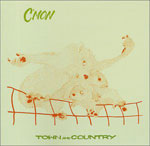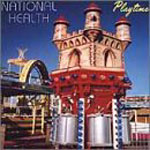Shared Obsessions
| |

| It's interesting reading Alistair's review of the A Certain Ratio reissue, Early, on Soul Jazz, as one of the things that confounded me getting to grips with it is that I have absolutely no cultural reference points to refer it to beyond an ACR compilation tape Alistair made me just a few weeks ago. ACR were never part of my musical landscape, and it's no good everyone trying to place them alongside 23 Skidoo and other early 80s punk-funkateers as they simply weren't there at the time for me. I don't even recall reading about them in the NME, Sounds or Melody Maker. Only afterwards in the critical overviews and 'neglected genius' articles. So coming to them cold - and my promo copy only includes the first CD of the two the sold version contains, so I can't comment on the remixes of the missing CD - what do I hear? Well, I love the first two tracks, 'Do the Du' and 'Flight', which are spacious, slightly eery tracks, but pretty soon it seems to me the music enters that uptight funk place that Heaven 17 used to hang out in. Big synths, robotic rhythms and slap bass; oh, and grunted/chanted vocals. 'Sounds Like Something Dirty' says track 11. Does it? Well, no, something squeaky clean and hung up to dry, actually. Better are the strange obsessions of two recent CDs, C'mon by Town and Country [Thrill Jockey] and Hanging Gardens by The Necks [Fish of Milk/ReR]. Town and Country are Chicago post-rockers intent on playing minimalistic instrumentals which I assume are improvisations. A kind of postmodern chamber music drawing on recent rock and jazz music than contemporary classical. The Necks insist on playing live, in this case for over an hour, producing the kind of minimalistic, repetitive jazz-ambient music that you'd normally expect to find studio-generated using drum machines, synthesizers, computers and samplers. But the real-time playing does something else, the music ebbs and flows, introduces and re-introduces snippets of themes and half-remembered earlier moments. It's great music to live with: leave it on for the day with the auto-repeat button on. |

| National Health were part of my teenage listening, a loose kind of jazz-rock outfit with Henry Cow and prog-rock connections, but also affiliated to the so-called 'Canterbury scene' which to these ears produced very little worth listening to beyond early Soft Machine. National Health made quirky, busy tuneful music, most of which was gathered on a double CD a few years back. But now Playtime has turned up, and it seems that by replacing the uptight Dave Stewart* in his own band, improvising together and generally enjoying playing, at the end of the 70s National Health were having a good time as well as pushing at the boundaries of jazz and rock music. On this live album released 22 years on, they're at their peak, the music buzzes and bursts with enthusiasm and joy, as it lurches and lopes along. [*No, not the Eurythmics Dave Stewart, another one. Used to play with Egg, and after leaving National Health had a couple of hit singles with Barbara Gaskin. I tried to interview him once and got back a conservative rant about how no-one these days can play anything, there was nothing worth listening to, and what was the world coming to... (Zzzzzzzzzzz) But don't let me put you off!] Also from way back when is a a Cold Blue reissue of a sampler first issued in 1984. Simply called Cold Blue it presents 13 tracks as what can be seen as a manifesto for the label [now recently resurrected as you'll know from reading my recent review article]. These are considered, careful compositions which, broadly speaking, can be classed as quiet post-minimalist. Harold Budd makes an appearance, as do the regular Cold Blue crowd of composers, four of whom turn up on Adams Cox Fink Fox, which should probably be called a Marty Walker album, as Walker plays all the clarinets. This is a beautiful collection of six compositions for small ensembles [clarinet, vibraphone & marimba, piano, violin, viola and cello] which repay careful and close listening. They are quietly experimental and new, yet tuneful enough for even the most conservative of classical music listeners. What's really brought this group of reviews together, beyond the fact the CDs above are what's being played here, is thinking about obsession and shared pasts. Sometimes a passion for something is enough to get you through, or enough for you to get through to someone else... only occasionally, however, do you find someone who shares so much of your past obsessions as Francis Spufford does mine in his book The Child that Books Built: A memoir of childhood and reading [Faber]. For before music there were stories for me. From the age of 5 I devoured books; indeed, I still do. Famous Five, Lone Pine Five, Secret Seven, Swallows and Amazons, Alan Garner, Biggles, Stig of the Dump, Narnia and lots more. I've even kept lists of 'Books Read' for most of the years since 1975 - just the kind of thing I can donate to the nation's heritage in my old age! |

| Spufford, too, read these [the kids' books, not my reading lists] and other books I've never heard of. He may have been born in 1964, a little later than me, and had a seriously ill sister I didn't have, but he, too, regularly navigated the local library's inner depths in search of new stories, he too read and read and read at every opportunity, disappearing into imaginary worlds and adventures. Spufford not only shares his enthusiasms, but includes some basic sociology, literary theory, and such like as comment on his past, but it is the enthusiasm, the nostalgia and clarity of experience in what he writes that is the centre of the book. Later, as he moves towards James Bond novels on the way to adult books [as opposed to the Alistair Maclean and Hammond Innes books which marked my passage to grown-up stories], which are never quite as magical or special, the chapters get shorter, the asides more limited... I wish he'd enthused and rambled more earlier in his book if I'd known he was going to grow up, too. I want to know about his later enthusiasms, too. I know we share a thing for the South Pole. [He previously wrote I May be Some Time: Ice and the English Imagination, a superb book about Antarctica.] Did that come out of early reading about Captain Scott? In lists he mentions several books he read that he doesn't deal with at all in any detail. If you're going to be obsessive then let's be obsessive. Let's plot every last word and sentence, the move to adult fiction and beyond, perhaps even the music that surely must have crept into his life like it did mine, jostling for space with words to this day. And he doesn't deal at all with the fetishisation of books as objects, or indeed LPs or CDs [or 7-inch singles, whatever they are, Alistair] as objects of desire either. Because surely there's nothing better than a beautiful new book that looks right: cover art that fits the contents, an uncracked spine, a typeface that suits, paper and ink that smell right. If you feel that too, then I recommend A Book of the Book: some works & projections about the book and writing, edited by Jerome Rothenberg and Steven Clay [Granary Books] to you. It gathers up artists' books, occult and mystical texts, outsider art, bibliographic oddities, notes on alphebtical systems, poetics and literary theory, in a glorious 536 page hotchpotch. It's one to dip into, a treasure chest of obsession for the obsessed. © Rupert Loydell, 2002 2002 |